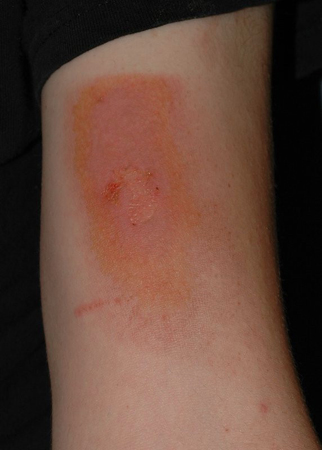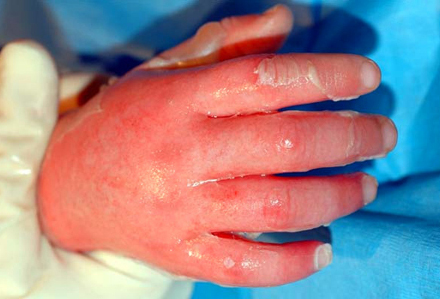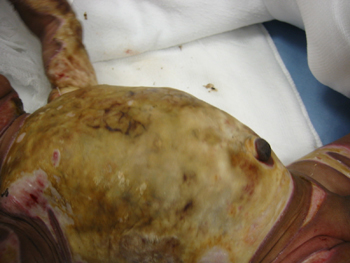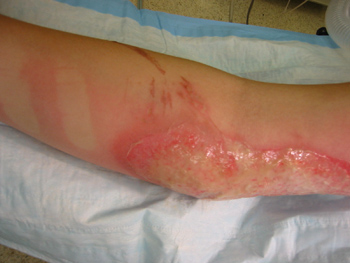History and exam
Key diagnostic factors
common
presence of risk factors
Key risk factors include young children, age >60 years, and male sex.
erythema
Indicative of a first-degree burn. [Figure caption and citation for the preceding image starts]: First-degree burnFrom Dr Sheridan's personal collection [Citation ends].
dry and painful burns
Classified as first-degree burns and involve the epidermis only. [Figure caption and citation for the preceding image starts]: First-degree burnFrom Dr Sheridan's personal collection [Citation ends].
wet and painful burns
Classified as second-degree burns and involve the epidermis and upper dermis. [Figure caption and citation for the preceding image starts]: Second-degree burnFrom Dr Sheridan's personal collection [Citation ends].
dry and insensate burns
Classified as third-degree burns and involve the epidermis and dermis and damage to appendages. [Figure caption and citation for the preceding image starts]: Third-degree burnFrom Dr Sheridan's personal collection [Citation ends].
burns affecting subcutaneous tissue, tendon, or bone
Classified as fourth-degree burns. [Figure caption and citation for the preceding image starts]: Fourth-degree burnFrom Dr Sheridan's personal collection [Citation ends].
cellulitis
The most common wound infection in small outpatient burns is cellulitis, usually caused by Staphylococcus aureus. This infection presents with expanding wound erythema, which, if untreated, will progress to lymphangitis and systemic toxicity.[Figure caption and citation for the preceding image starts]: CellulitisFrom Dr Sheridan's personal collection [Citation ends].
clouded cornea
Suggests a serious burn. Any suspicion of eye injury warrants an ophthalmological consultation.
Risk factors
strong
young children
weak
female sex (thermal burns)
Worldwide, females have slightly higher rates of death from burns compared to males. WHO: fact sheet - burns Opens in new window This may be due to increased risks associated with cooking (open fire or other unsafe cooking environments) especially if loose clothing is worn, open flames for heating and lighting, and possibly also from self-directed or interpersonal violence. This contrasts with the usual injury pattern, where rates tend to be higher in males (e.g., due to increased risk-taking behaviours, occupational exposures), and in some countries burn rates may be higher in males for these reasons. Chemical and electrical burns are generally more common in males.[4]
Use of this content is subject to our disclaimer